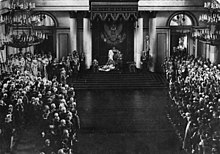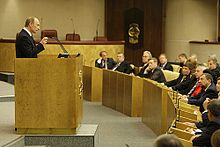State Duma
![]()
This article is about the Russian parliament, for other meanings see Duma (disambiguation).
![]()
This article or section is still missing the following important information:
Duma tasks. --Zimaro (Discussion) 08:56, 5. Mar. 2014 (CET)
Help Wikipedia by researching and adding them.
The Duma (Russian Ду́ма) or State Duma (Государственная Дума Gossudarstvennaya Duma) is the lower house, the 2nd parliamentary chamber of the Federal Assembly of Russia directly elected by the people. The word Duma (German Gedanke) derives from the Old Slavic and Russian dumat' (German nachdenken) and generally refers to a deliberative assembly or body, for example a city council, but also its meeting house.
Genesis
Originally, the Duma was an assembly of the secular sovereigns (boyars), who formed a counterweight to the clergy in the Semski Sobor. In 1649 the Semski Sobor consisted of 315 members. Under the Romanovs, this assembly of estates gradually lost its importance. In 1721 Peter the Great created the Governing Senate and increasingly limited the power of the clergy. The Senate and also its successor institutions consisted of only a few persons, a separation of powers practically did not exist. Only the State or Imperial Council, which was appointed by the tsar and was predominantly staffed by members of the aristocracy, finally grew to 90 members by 1905.
The introduction of democratic institutions began in imperial Russia with the formation of local self-governments in the countryside (Semstvo) in 1864 and in the cities (City Duma) in 1870.
First State Duma of 1906
After the St. Petersburg Bloody Sunday and the revolution of 1905 that it triggered, Tsar Nicholas II agreed in the October Manifesto to the creation of a State Duma as a second chamber alongside the Imperial Council. This first all-Russian parliament was elected from March 26 to April 20, 1906. While the socialist parties boycotted the election, the liberal reformers had high hopes for the first Duma, which met in the Taurian Palace. However, the parliament was largely dependent on the power of the Tsar. The government reserved the right to rule by emergency decrees during recesses, which had only to be subsequently confirmed by the Duma. The Duma was opened by the tsar on 27 Apriljul. / 10 May 1906greg. but was dissolved again after only 72 days, on 8 Julyjul. / 21 July 1906greg. The reason for this was that the deputies were undertaking a comprehensive agrarian reform, which the Tsar opposed. The protest against the dissolution, the Vyborg Manifesto, however, died away without result.
Second State Duma of 1907
The second State Duma also met for only a few months, from February 20 to June 2, 1907. Since the socialist parties had participated in the election this time, they constituted the majority in parliament. The new deputies pressed even more uncompromisingly for the solution of the agrarian question than their predecessors. Therefore, Prime Minister Pyotr Stolypin induced the tsar to dismiss them early. By decree of June 3, 1907, Nicholas II, contrary to his promises in the October Manifesto, changed the electoral law in such a way that towns, landless peasants, and non-Russian minorities were severely disadvantaged compared to the Russian upper middle class and nobility.
Third State Duma of 1907
The third State Duma, which convened that same year on November 1, 1907, was therefore dominated by conservative, nationalist, and pro-government parties such as the Octobrists. But even in this parliament, which remained for a full legislative term, until June 9, 1912, Stolypin and his successors did not find lasting majorities.
Fourth State Duma of 1912
The same was true of the fourth State Duma, which was constituted on November 15, 1912. Since the beginning of the First World War in 1914, it temporarily suspended its sessions. After the outbreak of the February Revolution of1917 the Duma majority urged the last government of the tsar to resign and formed from itself the Provisional Government under the liberal Prince Lvov, a member of the Constitutional Democrats. This exercised dual rule in competition with the Petrograd Soviet and later the First All-Russian Soviet Congress until the October Revolution of that year. On October 6, 1917, the Provisional Government formally dissolved the Duma in view of the upcoming Constituent Assembly.
The Council of People's Commissars, the Bolshevik revolutionary government under Lenin, which ruled shortly thereafter, finally abolished the Duma by decree on December 12, 1917. The element of the legislature, in the then only rudimentarily existing separation of powers, was then taken over by the Second All-Russian Soviet Congress and its All-Russian Central Executive Committee elected from it.
| Distribution of seats in the State Duma from 1906 to 1917 | ||||
| Fraction | 1st Duma | Second Duma | 3rd Duma | 4th Duma |
| April-June 1906 | February-June 1907 | 1907–1912 | 1912–1917 | |
| Social Democratic Workers' Party of Russia | - — | 65 | 14 | 14 |
| Social Revolutionary | - — | 34 | - — | - — |
| Trudowiki | 94 | 101 | 14 | 10 |
| Progressives | - — | - — | 39 | 47 |
| constitutional democrats | 179 | 92 | 52 | 57 |
| Nationalities | 121 | - — | 21 | 26 |
| Centrists | - — | - — | - — | 33 |
| Octobrists | 17 | 32 | 120 | 99 |
| Nationalists | - — | - — | 76 | 88 |
| Extreme rights | 15 | 63 | 53 | 64 |

Tsar Nicholas II opens the Parliament with a speech from the throne (1906)
The Duma in post-Soviet Russia
Establishment of the Duma
After the dissolution of the Congress of People's Deputies by Russian President Boris Yeltsin on 21 September 1993 and after his victory over Congressional opposition in October 1993, he presented a new constitution: It is based on the principle of separation of powers, and on December 12, 1993, the voting population gave its approval in a referendum. The bicameral parliament provided for in the constitution consists of the Federation Council, which represents the 83 (currently 85) subjects of the Russian Federation, and the State Duma, which has 450 deputies. Until December 2003 and again since 2016, half of them are elected by lists, the other directly (ditch voting); in between, the composition of the Duma was determined by proportional representation (with a 7% threshold). Each deputy is elected for a four-year term (Article 96). Russian citizens can be elected to the Duma at the age of 21 (Article 97). The State Duma must confirm the head of government appointed by the president, may censure the government, and passes laws that must be approved by the Federation Council and signed by the president. The Duma has a comparatively weak position vis-à-vis the president in Russia's semi-presidential system - similar to the French parliament of the 5th Republic. By 2016, the Duma had earned the nickname "the wild printer," this because the parliament had passed restrictive laws backed by the Kremlin at record speed. Gleb Pavlovsky wrote in early 2020 on the Duma that there the "calls from the Kremlin" determined the agenda of the State Duma, and thus the work of the government.
See also: Russian political system
Duma 1993
The first State Duma under President Boris Yeltsin and State Duma Chairman Ivan Rybkin was elected for only two years at the parliamentary elections on 12 December 1993.
Duma 1995
In the parliamentary election on 17 December 1995, the Duma was elected for a normal legislative period of four years. Russia's party spectrum was highly fragmented. 49.5% of the electorate voted for one of the parties that failed to reach the 5% threshold. The strongest party was the CPRF with 22.3% of the vote, followed by the LDPR (11.2%). The party "Our House Russia" received 10.1%, Yabloko 6.9%.
Duma 1999
In the parliamentary election on December 19, 1999, the CPRF received 24.3 %, but the pro-Putin lists "Unity" (="Bear") and "Fatherland - All Russia" together received more, with 23.2 % and 13.3 %, respectively. In the democratic spectrum, the Union of Right Forces received 8.5%, Yabloko 5.93%. The Zhirinovsky bloc was also represented in the Duma with 5.98%.
Duma 2003
In the fourth parliamentary elections on 7 December 2003, the parties close to the government of Vladimir Putin (for example, Yedinaya Rossiya - United Russia) won an absolute majority of seats. The right-wing nationalist Liberal Democrats (LDPR) also gained votes, while the opposition Communist Party of the Russian Federation, previously the strongest faction, lost. The Western-oriented liberal parties Union of Right Forces and Yabloko failed to clear the five-percent hurdle. There were 44 women among the 450 deputies.
In the autumn of 2007, before the parliamentary elections, the following factions were represented in the Duma:
- United Russia (301 seats out of 442)
- Communist Party of the Russian Federation (47)
- Liberal Democratic Party of Russia (29)
- Rodina [People's Patriotic Union] (33)
- People's Patriotic Union "Rodina" (11) (eight members of Rodina split from the party and formed their own parliamentary group, but kept the same name)
- Non-attached (21)
Duma 2007
The parliamentary elections on 2 December 2007 resulted in the following distribution of seats:
| Party | Number of seats |
| Some Russia | 315 |
| Communist Party of the RussianFederation | 57 |
| Liberal Democratic Party of Russia | 40 |
| Just Russia | 38 |
| totally thereof male / female | 450 388 / 62 |
Compared to the situation before the elections, the relative share of seats held by the ruling party United Russia has increased slightly to 70 %. With the election, the representatives of a development of Russia along the lines of Western democracies have completely disappeared from parliament. Previously, they had been represented in the Duma as non-attached deputies. However, the possibility of being elected to parliament as an individual candidate was abolished before the election.
See also: List of deputies of the 5th State Duma of the Russian Federation
Duma 2011
The parliamentary election on 4 December 2011 resulted in the following distribution of seats:
| Party | Number of seats |
| Some Russia | 238 |
| Communist Party of the Russian Federation | 92 |
| Just Russia | 64 |
| Liberal Democratic Party of Russia | 56 |
| totally | 450 |
The share of seats for United Russia fell to 53% (after 70% in 2007), from which the other three parties previously also represented in the Duma benefited: the Communist Party improved to 20.4% (after 12.7% in 2007). Just Russia improved to 14.2 % (after 8.4 % in 2007) and the Liberal Democratic Party to 12.4 % (after 8.9 % in 2007).
After the election, there were massive protests and demonstrations against alleged electoral fraud.
Duma 2016
At the end of May 2015, it became known that efforts were underway to bring forward the 2016 parliamentary election in Russia from December to September 2016. In July, the Federation Council Committee recommended this postponement. Critics noted that the postponement of the 2016 parliamentary election in Russia served to disregard the election campaign, as well as to achieve a lower expected voter turnout, since holidays are taken in Russia during the summer. In addition, there was the hopelessness of a real election, since only the ruling party and the "system opposition" supporting it had a chance with the reintroduced system of direct mandates. Voter turnout in this early election was correspondingly low at 47.8 percent, compared to 60 percent in 2011; in the cities it was even lower, reaching only 30 percent in Moscow. In surveys, based on their expectations, over 20 percent of respondents had agreed to sell their vote themselves.
.jpeg)
ID of the deputies of the State Duma

Prime Minister Vladimir Putin addresses the State Duma (May 8, 2008)
Search within the encyclopedia